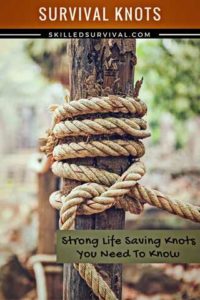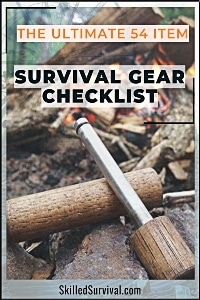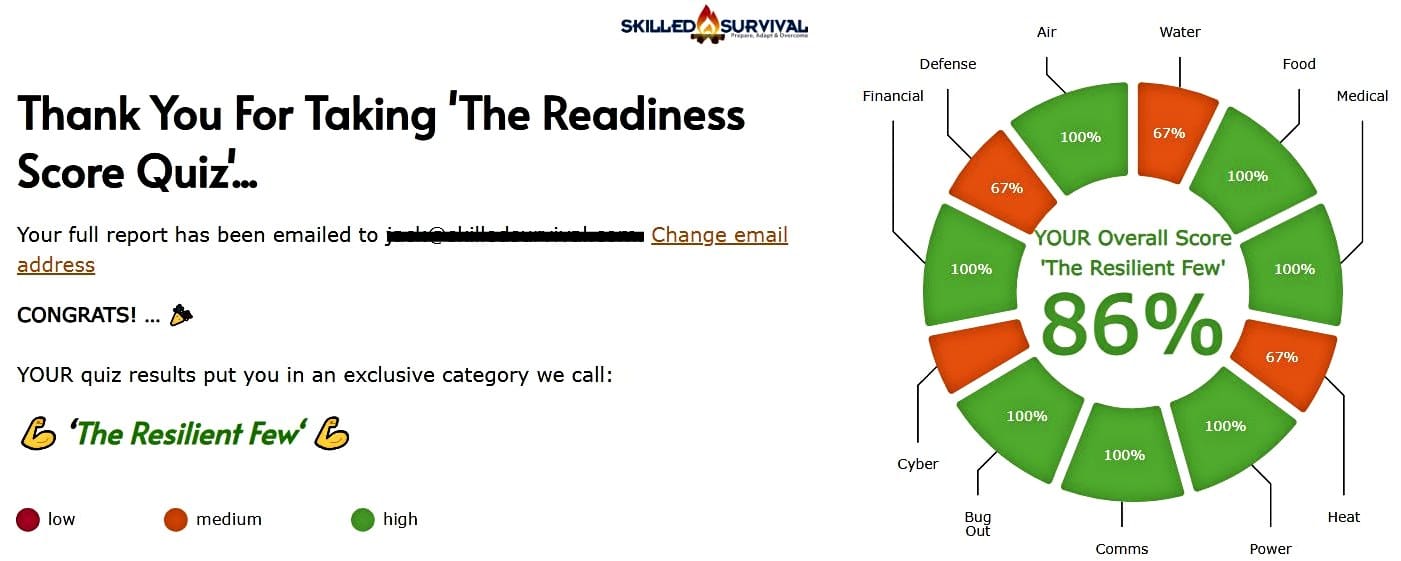
A List Of The Best Survival Knots EVERYONE Should Know
Whether you’re an:
- avid camper
- a determined mountaineer
- or a wilderness explorer
There’s ONE skill you must have in your repertoire:
Knot Tying
It’s something you did as a kid for fun, and now it can save your life as an adult.
Today, I want to show you the best survival knots and how to tie them like a pro:
TOPICS IN THIS LIST… ↓(click to jump)
- 1. Figure Eight Knot
- 2. Fight Eight on a Bight Knot
- 3. Bowline Knot
- 4. Clove Hitch
- 5. Sheet Bend
- 6. Taut-Line Hitch
- Why You Must Learn These Knots

Want a free 54 item survival gear checklist?
Enter your email below to instantly download this Complete Checklist PDF. No purchase necessary. 👇 👇NOTE: If you prefer video content, this tutorial covers the 6 best survival knots:
↓ 6 Must-Know Survival Knots!
1. Figure Eight Knot
A figure-eight knot has three main variations:
- the simple figure eight
- figure-eight follow-through
- figure eight on a bight
The first knot, as the name implies, is a basic figure-eight knot.
The two others add to the original configuration and expand the uses of the knot.
This is one of the strongest knots you can tie and maintains up to 85 percent of the rope’s strength.
This means the rope is unlikely to break while you use it.
↓ How to Tie a Figure 8 Knot for Climbing
Survival Uses
In its simplest form, a figure-eight knot at the end of a rope can keep you from sliding off it.
It’s secure and won’t come undone because of pressure.
You can also create knots along a rope that stay in place and are large enough to grab onto when climbing.
The figure-eight follow-through is one of the most useful types of knots for climbing.
One reason is that you can make a secure loop at the end of a rope with it, an advantage when someone needs to be hauled up safely.
And it can also be used as a foothold when grabbing the rope is difficult because of weather conditions.

Want a free 54 item survival gear checklist?
Enter your email below to instantly download this Complete Checklist PDF. No purchase necessary. 👇 👇2. Figure Eight on a Bight Knot
Figure eight on a bight knot creates a strong loop at the rope’s end that can be clipped onto an anchor.
You can also create stable loops in the middle of the rope to use as handholds or footholds.
It’s an important survival knot for anchoring, especially when working in high winds or carrying gear up or down a steep incline.
↓ Learn how to Tie a Figure 8 on a Bight
Drawbacks
The biggest drawback of using the figure-eight knot is that it can be extremely hard to untie.
This is especially the case if it has been used repeatedly.
It also uses a lot of rope length.
On the other hand, it’s easy to tell if you’ve tied it the wrong way with a quick examination.
Common Mistakes and How to Fix Them
The only real mistake you can make with a figure-eight knot is to add an extra loop to the figure.
This is easily spotted by examination, though.
3. Bowline Knot
Like the figure-eight knot, the bowline will hold thousands of pounds of pressure.
One difference is that it’s easier to untie after use than a figure eight.
The bowline may be the most dependable survival knot you need to learn.
It’s also a versatile knot, with various ways to use it.
↓ How to Tie the Most Useful Knot in the World (Bowline)
Survival Uses
You can tie the bowline around things or through them and tie it around yourself (even one-handed).
Tying it with just one hand can be a boon when you need to tie a knot in an emergency.
A bowline knot forms a loop at the end of a rope, and the knot tightens more with any increase in pressure on the loop.
That’s why it’s useful for hanging items from tree limbs, like food and survival gear.
Drawbacks
Due to human error, the bowline can’t be depended on when climbing.
It’s not difficult to use the bowline incorrectly.
The knot can come untied if the loop is pulled sideways.
Common Mistakes and How to Fix Them
Because the knot can become undone, creating a stopper knot beneath the bowline will increase its safety.
4. Clove Hitch Survival Knot
A hitch is a knot that connects a rope to an object.
The clove hitch is a simple but important knot that’s easy to tie.
The benefits are that it doesn’t loosen or slip, and you can lengthen or shorten the rope without untying the knot.
↓ Tie A Clove Hitch Knot
Survival Uses
A clove hitch isn’t as strong as the figure eight or bowline knots, but it’s a good knot for anchoring.
It will help you fasten a shelter because it stays tight and doesn’t usually slip or loosen.
The clove hitch allows the rope to adjust without untying the knot, making it useful for lowering heavy objects or moving them to a higher spot.
Drawbacks
Constant movement, like the kind caused by a fierce wind, will eventually loosen the knots, causing a shelter to become unstable.
Checking the knots frequently will allow you to adjust and tighten them.
Common Mistakes and How to Fix Them
The clove hitch works best with pressure on the line, so it’s good for keeping a tarp or tent stretched.
Don’t use a clove hitch if the object it’s tied to rotates because the knot could come untied.
5. Sheet Bend Survival Knot
If you need a longer piece of rope than you have available, the sheet bend will allow you to tie shorter pieces together safely.
It works even if the two ropes are dissimilar in size or each is made of a different material.
↓ What Knot to Do | Sheet Bend is Possibly the most useful knot ever
Survival Uses
Any method of using rope for survival can benefit from the sheet bend.
It’s a way to put every scrap of rope or paracord to good use.
It’s also an efficient way to tie together several short strands of cord to make a cargo net if you don’t have enough longer rope to use.
And cargo nets are a basic building block in making hammocks, stretchers, snowshoes, and fishnets.
Drawbacks
The sheet bend isn’t a very strong knot, coming in at a breaking strength of 55 percent.
It can also come loose if the rope is particularly smooth or if there isn’t much pressure on the knot.
If the two ropes are different in size, making a double bend with a smaller or more flexible cord makes the knot more secure.
Common Mistakes and How to Fix Them
The most frequent mistake is tying the sheet bend with the short end of one rope on the wrong side of the knot.
This is sometimes called the “left-hand sheet bend.”
You can check your work by ensuring that both free rope ends are on the same side of the knot.
6. Taut-Line Hitch Knot
The main benefit of the taut-line hitch is that it can slide up and down the cord and tighten it.
This keeps the rope taut and makes the amount of pressure adjustable.
The hitch is also easy to untie when no longer needed.
↓ Useful Survival Shelter Knot – Tautline Hitch
Survival Uses
A taut-line hitch is what you use when sheltering under a tarp.
Stringing a rope between two trees and laying your tarp over it is the first step in creating a buffer between you and the elements.
To make the tarp into a shelter, you need a firm tightrope to hang it from.
A taut-line knot allows your loop to slide and grip, making it much easier to stake in a large waterproof survival tarp.
Drawbacks
The taut-line hitch won’t work for getting a rope tight and keeping it that way.
It’s best for easy duty tasks, and it often requires adjustments.

Want a free 54 item survival gear checklist?
Enter your email below to instantly download this Complete Checklist PDF. No purchase necessary. 👇 👇Common Mistakes and How to Fix Them
It’s not hard to accidentally reverse the direction of the rotation when tying the knot, causing it to be weaker.
You can check this by ensuring the rope ends face in the same direction.
There are different variations of the Taut-Line Hitch.
The one shown above is the Midshipmen’s Hitch which is the most secure but may be harder to adjust after going through heavy tension.
Many people tend to tie the Magnus Hitch, which is harder to twist but has a higher chance of slipping.
In the last part, remember to reverse the direction when tying the last half hitch to tie the more secure variation of this hitch.
Why Should You Learn These Knots
The short answer is that they can save your life.
The more of these dependable survival knots you learn, the better off you’ll be under adverse conditions.
If you must navigate difficult terrain while hauling supplies, some knots will help make it easier and safer.
The best fishing knots and trapping game could keep you from starving.
There’s a reason firefighters and Coast Guard rescue crews learn how to tie these knots.
A secure rope can save someone from a burning house or a raging storm in a life-or-death situation.
You can meet with fire and flood in the backcountry.
And you’ll need to know how to erect a sturdy shelter to protect yourself from the elements.
That’s why it’s best to start with the best knots for survival and frequently practice until you can tie them with ease.
You won’t regret it.
Author Bio
Paul Turner owns Take Outdoors, a website for outdoor enthusiasts. If you are new to camping, he’s written a comprehensive guide to Camping for Beginners that may interest you.
P.s - I just took this FREE 60-second 'Readiness Score Quiz'👇
AND... I've still got a few gaps in my preps...🤔 But at least, I'm not part of 'The Fragile Masses'. 👍 Find out where YOU stand by answering a few questions...

Recommended Reading
Survival Pack: How To Build One NOW (before SHTF)
A complete list of critical items that need to be in your survival pack before heading out into the wilderness.
Best Survival Packing List To Plan For An Evacuation
Everyone needs a survival packing list to organize their escape. That way you won't regret leaving something critical behind.
13 Best Wild Edibles ANYONE Can Find Nearly Everywhere…
Discover the best wild edible plants you can find and eat nearly anywere. Knowing and identifying these wild edibles could save your life.
How To Make Catfish Bait: My Grandpa’s Ultimate Recipe
I want to share with you what I consider the best catfish bait recipe. Here's how to make stink bait that will get the catfish to bite.
Paracord Projects: 17 Useful Survival Tools You Can Make Today
I share the best paracord projects that are both fun and useful. By doing these crafts you'll always have lifesaving cordage on hand.
Best Survival Skills Everyone Should Master
The best survival skills will keep you alive even in extreme conditions. 1. Water 2. Shelters 3. Fire 4. Navigation 5. Signaling 6. Medical 7. Foraging...